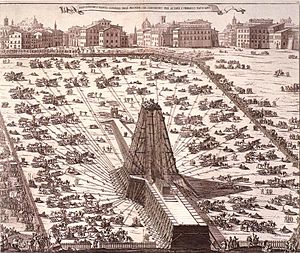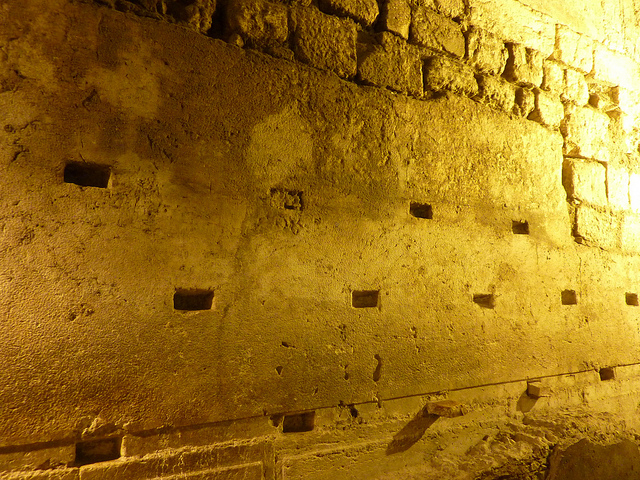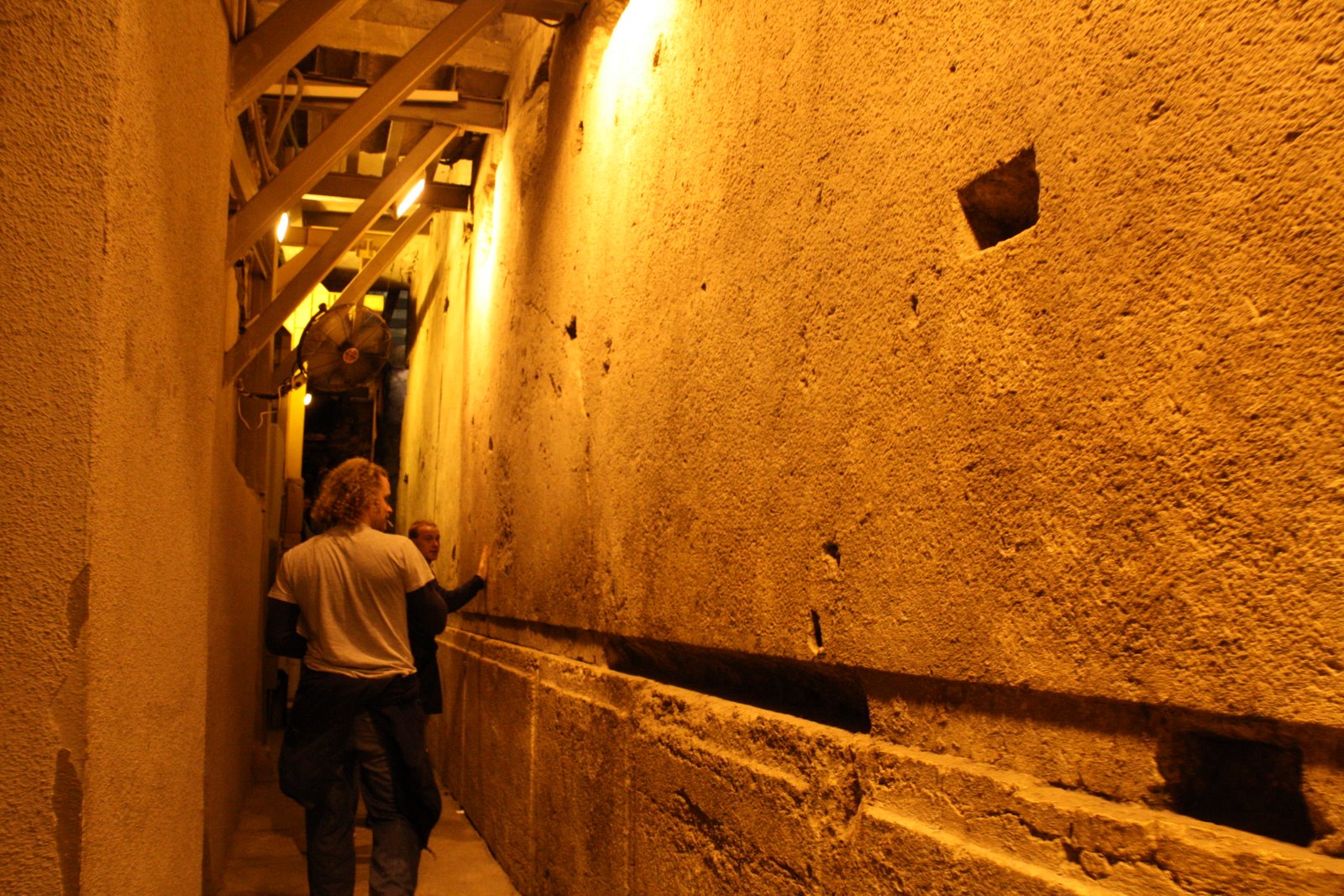It looks like you're using an Ad Blocker.
Please white-list or disable AboveTopSecret.com in your ad-blocking tool.
Thank you.
Some features of ATS will be disabled while you continue to use an ad-blocker.
share:
For replication of the h blocks. There is anythin saying in construction "measure twice cut once". Any large block a mistake was made in would
simply be worked into a few smaller blocks. With one original on hand for measurements to be taken from a skilled craftsman would be able to replicate
it with precision. No laser scanning tech or intricate casting molds necessary. If they were cast why are there no air pockets visible even in core
samples? It will take a lot of vibration to dislodge air bubbles from so many sharp 90 deg edges. Even the fringe theorists who propose casting molds
for the h blocks say holes in the stones were drilled yet none of tthe interior surfaces appear like a cast cementitous product looks.
So not only did they dissolve, cast, and reharden the stone. They also manage to replicate the grain of the stone found in tthe quarry they got it from...
So not only did they dissolve, cast, and reharden the stone. They also manage to replicate the grain of the stone found in tthe quarry they got it from...
originally posted by: Wolfenz
Iroquois Mohawk - Norseman similarity's and Northern Cree - Laplander aka SAMI Culture
Like iF it was a One World Civilization in the Arctic Circle
Hell Even the SAMI and Mohawk & Cree Language Dialect is the Same
While I appreciate your effort, there are two points I'd like to make (not being fully caffienated, I'm limiting my response).
First off, given that early civilisations only had so many options in constructing big stuff, it is not surprising that they could look similar, though widely apart in in time and locale.
Second, I do have a paper linking the Algonquian culture to common roots with Finns and Magyars...way back, but it is my understanding that Cree (Algonkian) and Mohawk (Iroquoian) languages are linguistically about as far apart as English and Chinese. Just sayin'.
edit on 1-11-2014 by
JohnnyCanuck because: ...need..coffee...now!
Just to throw it out there, is anyone taking into consideration that there are limestones that are quite easily modified when fresh, or wet, and dry hard?
originally posted by: Jarocal
So not only did they dissolve, cast, and reharden the stone. They also manage to replicate the grain of the stone found in the quarry they got it from...
originally posted by: Hanslune
originally posted by: Quetzalcoatl14
You are right, the 1000 ton one is the unmoved one from the quarry.
However, there still are a lot of problems. You can't just add "they took a lot of years" as a simple answer. What about moving them into place perfectly? That's another counterargument.
Actually two of them and one in outline.
The actual method of moving the stones is not known of course but one can speculate on it. The only known facts are:
They were cut out of the quarry near the temple they were used to form a retaining wall for and they were moved an placed.
One idea
...and it probably took years to do
You can get an idea of what was needed by looking at how the Thunderstone was moved by the Russians and how the Romans (16th century) raised a number of fallen Roman (classical) obelisks they had taken from Egypt. The heaviest was the Lateran Obelisk which comes in at 455 tons. That was moved from Karnak in Egypt to Rome and erected in the 4th century/ re-erected in 1588.
Not just for a retaining wall as you keep saying there are quite a few of these colossal stones around the site -
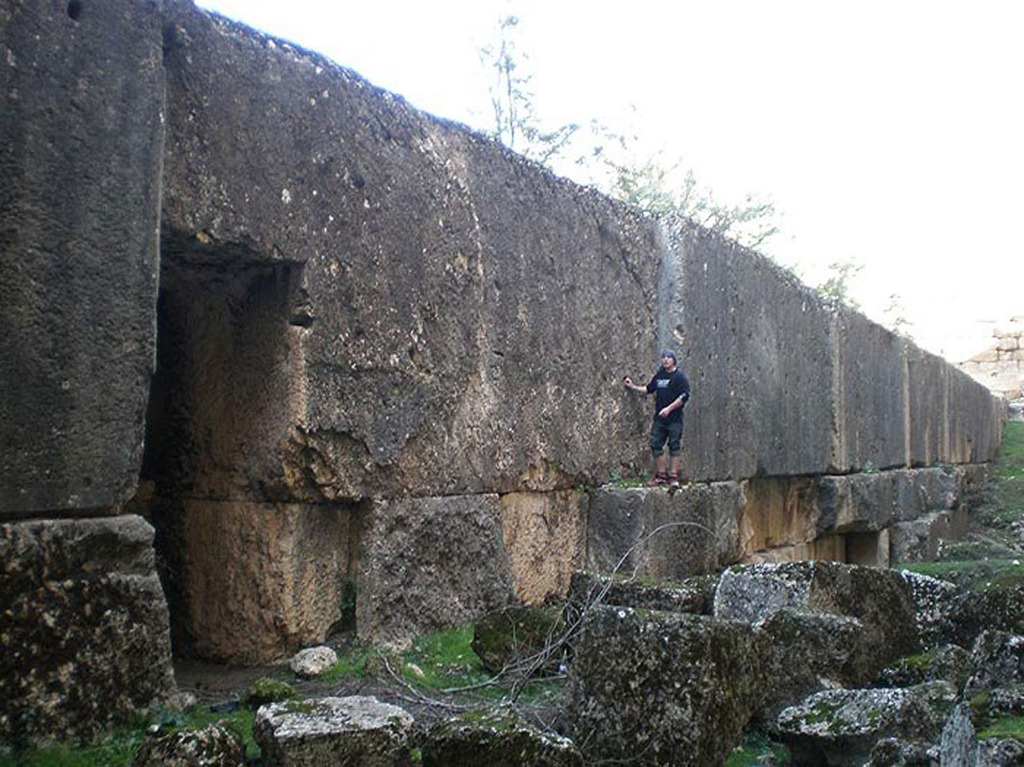
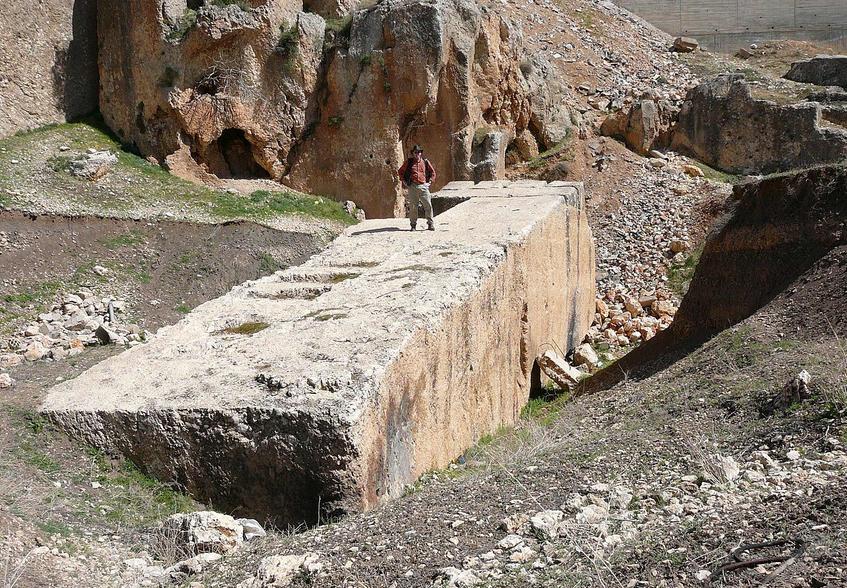
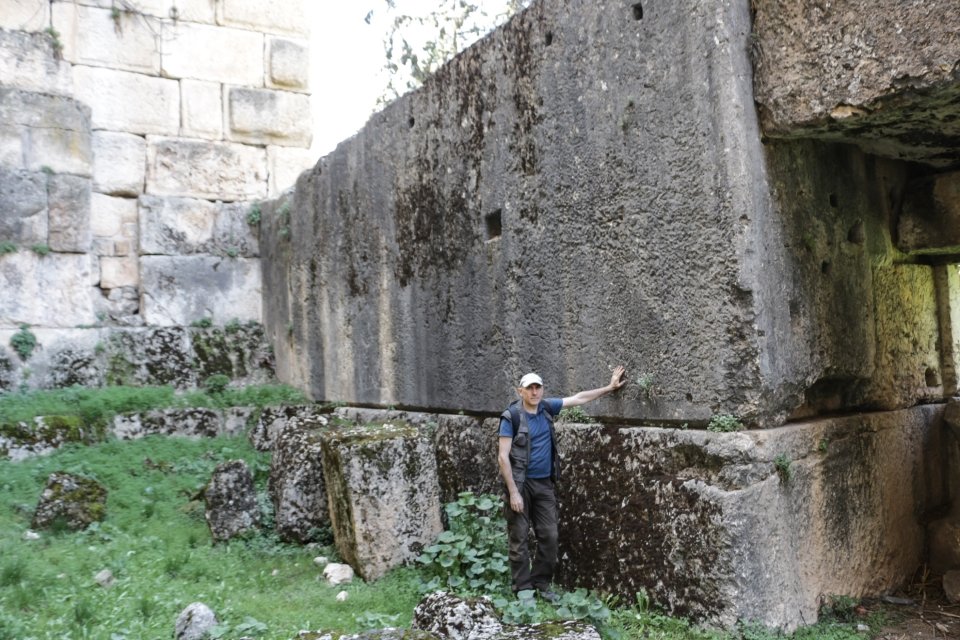
originally posted by: JohnnyCanuck
Just to throw it out there, is anyone taking into consideration that there are limestones that are quite easily modified when fresh, or wet, and dry hard?
originally posted by: Jarocal
So not only did they dissolve, cast, and reharden the stone. They also manage to replicate the grain of the stone found in the quarry they got it from...
Yes, I do a fair bit of lime plastering, the company I work for makes manufactured stone veneer and we install precast cement products( also foam backed exterior plasterer and cement based plaster). Concrete mixes are not as liquid as they appear. Differences in aggregate size/ratios affects the end product. In plaster fibers are used to avoid cracking and in concrete rebar or metal mesh is often used to accomplish the same.
Collect all tthe resources necessary to dissolve the rock, get the mix correct and pour the form, spend time to vibrate the air out and either it dries as a softer version of the ooriginal rock or something else needs to be bothered and processed to add to it chemically hardening the rock again. Differences in aggregate, environmental conditions such as temperature, humidity, and precipitation can all have implications on the end product. Without evidence of large scale mechanization which scenario seems more plausible? Thousands of masonry workers pounding on rock's with tools known to exist or the thousands that would be stripping the environment bare to collect and process the chemicals needed to dissolve tthat much stone, hundreds needed to collect the resources for mold making and repair, and the hundreds or thousands more collecting and processing the resources to add to the mix to harden it again.
a reply to: JamesTB
The three trils of 800 tons are in the retaining wall which is what we were talking about. As you have posted images and (again) forgotten to explain where they are I cannot comment on them. The larger one is the second 1,000 ton block left in the quarry at Baalbek
The three trils of 800 tons are in the retaining wall which is what we were talking about. As you have posted images and (again) forgotten to explain where they are I cannot comment on them. The larger one is the second 1,000 ton block left in the quarry at Baalbek
originally posted by: Hanslune
a reply to: Jarocal
Additionally the quarries filled with a huge back fill of debris, limestone debris.
I do not discount completely the use of such a substance being a trade secret of masons for finishing the stone wwith precision but the idea they were producing thousands of gallons of this substance to completely dissolve and then even more to harden it again stymied me. We apply acids today to clean stone and remove mortar providing a more aesthetic surface. It is not inconceivable to me this happened in "prehistory" as a closely guarded trade secret ssubsequently forgotten.
Without diverging too far from the thread I kind of see them as the ooriginal permaculture practitioners. To me, their world was much more connected to natural cycles and they were able to more directly recognize natural patterns because as a culture they had not separated themselves from nature as we have today. Look at the terraces for agriculture. That was a tremendous expenditure of resources to slow water flow and keep the soil hydrated higher the landscape. Pottery can be explained by a firepit dug in clay and noticing the walls of the pit hardened substantially.
Just looking at an immense stone aand saying we couldn't do that today is disingenuous. We couldnc.can work the stone today and even do it using the tools aaccepted as those cultures possessing. To me the better question is why did they expend such effort for these structures not all of which are religious in design. They were designed to last as long as stone, that's not looking out for your children or their children. That is designing with a very long legacy in mind. Otherwise smaller blocks with an earthen mortar could be expected to last a couple centuries.
originally posted by: Hanslune
a reply to: JamesTB
The three trils of 800 tons are in the retaining wall which is what we were talking about. As you have posted images and (again) forgotten to explain where they are I cannot comment on them. The larger one is the second 1,000 ton block left in the quarry at Baalbek
The second one? What do you mean by that? There's at least 4 mega blocks in the quarry at Baalbek and it still isn't fully excavated as you can see from this 2014 excavation photo -
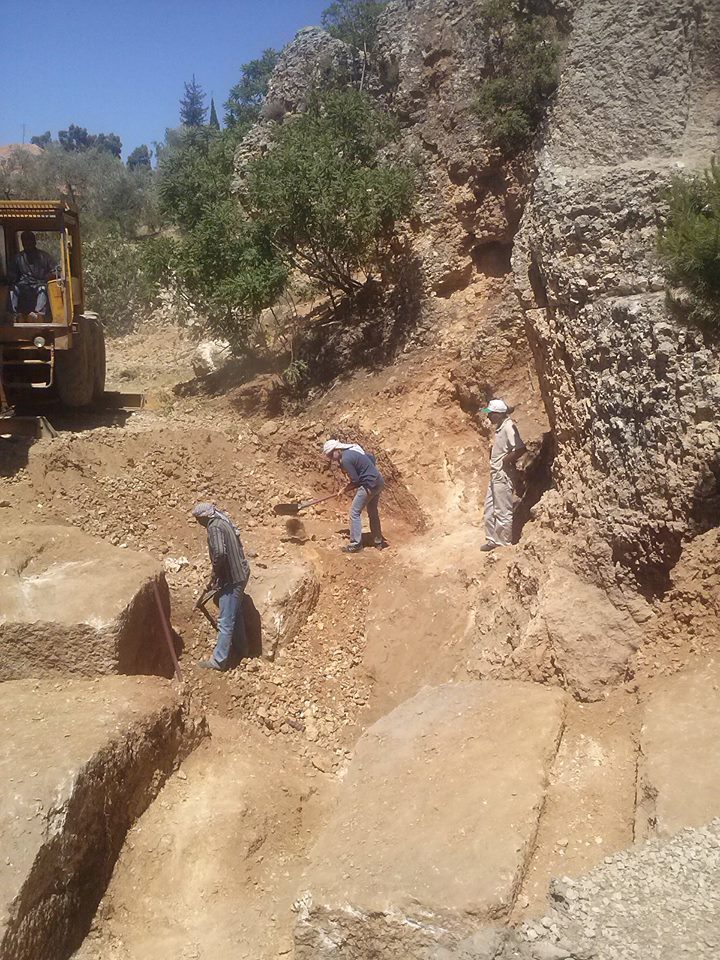
originally posted by: JohnnyCanuck
a reply to: Jarocal
Just for the record, I was not referring to dissolving the limestone, rather that large chunks can be more easily worked when 'fresh', and harden upon exposure to air...not like concrete cures with moisture. (I've poured acres).
My apologies for misunderstanding your post. There is a limestone quarry within 20 miles of me and it is the most popular for not veneer natural stone work where I live. Although I do find the limestone argument a bit of a side track when working at walls made from large blocks of andesite, granite, or dolomite.
originally posted by: Jarocal
originally posted by: JohnnyCanuck
a reply to: Jarocal
Just for the record, I was not referring to dissolving the limestone, rather that large chunks can be more easily worked when 'fresh', and harden upon exposure to air...not like concrete cures with moisture. (I've poured acres).
My apologies for misunderstanding your post. There is a limestone quarry within 20 miles of me and it is the most popular for not veneer natural stone work where I live. Although I do find the limestone argument a bit of a side track when working at walls made from large blocks of andesite, granite, or dolomite.
Hey, I don't know from walls...just a humble shovel-monkey.
originally posted by: JohnnyCanuck
originally posted by: Jarocal
originally posted by: JohnnyCanuck
a reply to: Jarocal
Just for the record, I was not referring to dissolving the limestone, rather that large chunks can be more easily worked when 'fresh', and harden upon exposure to air...not like concrete cures with moisture. (I've poured acres).
My apologies for misunderstanding your post. There is a limestone quarry within 20 miles of me and it is the most popular for not veneer natural stone work where I live. Although I do find the limestone argument a bit of a side track when working at walls made from large blocks of andesite, granite, or dolomite.
Hey, I don't know from walls...just a humble shovel-monkey.
I'm not a rocket scientist but I do smack rocks with a hammer for a living. I find it fascinating how masonry has changed over millennia with different end products but how masonmuch techniques are similar.
a reply to: SLAYER69
One idea that keeps popping up, is nuclear explosions in prehistory. And one place mentioned is the Sahara. Here is a well written article from 2009:
www.freerepublic.com...
NUMEROUS EVIDENCE OF PRE-HISTORIC NUCLEAR WAR EXISTS
"What we know today as the Sahara Desert was once a tropical region of heavy vegetation, abundant rainfall, and several large rivers. Scientists have discovered areas of the desert in which soils which once knew the cultivated influence of plow and farmer are now covered by a thin layer of sand. Researchers have also found an enormous reservoir of water below the parched desert area. The source of such a large deposit of water could only have been the heavy rains from the period of time before a fiery devastation consumed the lush vegetation of the area. "
www.apparentlyapparel.com...
EVIDENCE FOR ANCIENT NUCLEAR WAR ON EARTH
If you scroll down into their March 2014 Updates, you will see this:
"At the Oklo mine in Gabon, West Africa, in 1972, a company from France was searching for Uranium to fuel their nuclear power plants. In an area of stable geology, they found a number of deposits, all oddly enough in a straight row, and actively mined them.
"The problem occurred when they sent off this Uranium to be processed into nuclear fuel. It had already been processed, and used, and wasn't any good for new fuel. It was no good for producing power with. The isotope percentages were all wrong. They were NOT consistent with raw Uranium. They WERE consistent with used fuel, the kind that is pulled OUT of a nuclear reactor after use!
"The percentages were NOT consistent with any other previously known raw Uranium deposit. But the kicker is this. Embedded in each of these small Uranium deposits are detectable amounts of the element Plutonium, the primary ingredient of most modern atomic bombs."
***********************************************************************************************
The most curious aspect of this story, is that if it can be proved that our planet HAS experienced nuclear war in pre-history, enough carbon-14 was produced to COMPLETELY INVALIDATE any evolutionary/archeological timeline based on carbon-14 dating!
"If the world experienced a global nuclear war, one that produced enough radio-activity to halve the lifespan of man, it also produced enough carbon-14 to completely skew any evolutionary or archeological timeline that doesn't take this massive influx of carbon14 (and other radioactivity) into the system into account. The war and its radioactivity introduced so much Carbon14 (and other radiations) into the system that it both poisoned life, and completely changed the natural balance of production and decay of Carbon14 on Earth. Anything living before this war would appear to be much older than it actually is, because its Carbon14 levels were much lower than the levels found in organic/living things immediately after the war. So the whole method is skewed prior to 2000BC (there's that date again)."
One idea that keeps popping up, is nuclear explosions in prehistory. And one place mentioned is the Sahara. Here is a well written article from 2009:
www.freerepublic.com...
NUMEROUS EVIDENCE OF PRE-HISTORIC NUCLEAR WAR EXISTS
"What we know today as the Sahara Desert was once a tropical region of heavy vegetation, abundant rainfall, and several large rivers. Scientists have discovered areas of the desert in which soils which once knew the cultivated influence of plow and farmer are now covered by a thin layer of sand. Researchers have also found an enormous reservoir of water below the parched desert area. The source of such a large deposit of water could only have been the heavy rains from the period of time before a fiery devastation consumed the lush vegetation of the area. "
www.apparentlyapparel.com...
EVIDENCE FOR ANCIENT NUCLEAR WAR ON EARTH
If you scroll down into their March 2014 Updates, you will see this:
"At the Oklo mine in Gabon, West Africa, in 1972, a company from France was searching for Uranium to fuel their nuclear power plants. In an area of stable geology, they found a number of deposits, all oddly enough in a straight row, and actively mined them.
"The problem occurred when they sent off this Uranium to be processed into nuclear fuel. It had already been processed, and used, and wasn't any good for new fuel. It was no good for producing power with. The isotope percentages were all wrong. They were NOT consistent with raw Uranium. They WERE consistent with used fuel, the kind that is pulled OUT of a nuclear reactor after use!
"The percentages were NOT consistent with any other previously known raw Uranium deposit. But the kicker is this. Embedded in each of these small Uranium deposits are detectable amounts of the element Plutonium, the primary ingredient of most modern atomic bombs."
***********************************************************************************************
The most curious aspect of this story, is that if it can be proved that our planet HAS experienced nuclear war in pre-history, enough carbon-14 was produced to COMPLETELY INVALIDATE any evolutionary/archeological timeline based on carbon-14 dating!
"If the world experienced a global nuclear war, one that produced enough radio-activity to halve the lifespan of man, it also produced enough carbon-14 to completely skew any evolutionary or archeological timeline that doesn't take this massive influx of carbon14 (and other radioactivity) into the system into account. The war and its radioactivity introduced so much Carbon14 (and other radiations) into the system that it both poisoned life, and completely changed the natural balance of production and decay of Carbon14 on Earth. Anything living before this war would appear to be much older than it actually is, because its Carbon14 levels were much lower than the levels found in organic/living things immediately after the war. So the whole method is skewed prior to 2000BC (there's that date again)."
originally posted by: MKMoniker
a reply to: SLAYER69
EVIDENCE FOR ANCIENT NUCLEAR WAR ON EARTH
If you scroll down into their March 2014 Updates, you will see this:
"At the Oklo mine in Gabon, West Africa, in 1972, a company from France was searching for Uranium to fuel their nuclear power plants. In an area of stable geology, they found a number of deposits, all oddly enough in a straight row, and actively mined them.
"The problem occurred when they sent off this Uranium to be processed into nuclear fuel. It had already been processed, and used, and wasn't any good for new fuel. It was no good for producing power with. The isotope percentages were all wrong. They were NOT consistent with raw Uranium. They WERE consistent with used fuel, the kind that is pulled OUT of a nuclear reactor after use!
Naturally occuring fission was predicted before any discovery of such deposits, and explains them completely.
originally posted by: MKMoniker
"The percentages were NOT consistent with any other previously known raw Uranium deposit. But the kicker is this. Embedded in each of these small Uranium deposits are detectable amounts of the element Plutonium, the primary ingredient of most modern atomic bombs."
Not exactly a "kicker."
Trace amounts of plutonium are found naturally in uranium-rich ores.
Link
originally posted by: MKMonikerThe most curious aspect of this story, is that if it can be proved that our planet HAS experienced nuclear war in pre-history, enough carbon-14 was produced to COMPLETELY INVALIDATE any evolutionary/archeological timeline based on carbon-14 dating!
"If the world experienced a global nuclear war, one that produced enough radio-activity to halve the lifespan of man, it also produced enough carbon-14 to completely skew any evolutionary or archeological timeline that doesn't take this massive influx of carbon14 (and other radioactivity) into the system into account. The war and its radioactivity introduced so much Carbon14 (and other radiations) into the system that it both poisoned life, and completely changed the natural balance of production and decay of Carbon14 on Earth. Anything living before this war would appear to be much older than it actually is, because its Carbon14 levels were much lower than the levels found in organic/living things immediately after the war. So the whole method is skewed prior to 2000BC (there's that date again)."
Actually, your source has it backwards. Anything affected by some large spike in C14 production would appear to be younger than its actual age.
The idea that there was some nuclear war influencing world-wide C14 concentrations around 2,000 BC is completely ridiculous. You really need to utilize a different bogus source. One that allows you to back date before literate cultures existed, since there are plenty of records predating 2,000 BC, yet none mention any huge nuclear war.
Harte
originally posted by: JamesTB
There was one known, then there is a second one that was found a few years ago and the outline of third. If you have new information on further excavations please link to it please.
In your image I see no 'mega' blocks. Perhaps you should explain what your definition of mega is.
edit on 1/11/14 by Hanslune because: (no
reason given)
originally posted by: JohnnyCanuck
originally posted by: Wolfenz
Iroquois Mohawk - Norseman similarity's and Northern Cree - Laplander aka SAMI Culture
Like iF it was a One World Civilization in the Arctic Circle
Hell Even the SAMI and Mohawk & Cree Language Dialect is the Same
While I appreciate your effort, there are two points I'd like to make (not being fully caffienated, I'm limiting my response).
First off, given that early civilisations only had so many options in constructing big stuff, it is not surprising that they could look similar, though widely apart in in time and locale.
Second, I do have a paper linking the Algonquian culture to common roots with Finns and Magyars...way back, but it is my understanding that Cree (Algonkian) and Mohawk (Iroquoian) languages are linguistically about as far apart as English and Chinese. Just sayin'.
Seeing your , Canadian and have Better understanding then most about the Area
Common Roots is right.. to many Traits... and Points ...
Yeah in a sense your right.. but it the the Wording of the Language it is how they are pronounced ..in the Dialect
is what im more focused on. but for English and Chinese total different pronunciation ... English is like other Germanic Language in pronunciation, the Combination of the Main's German and French ( Frankish )
Well this is interesting
Singing a Paul McCarthey Song ( Blackbird ) in Total Mohawk Language
ok J.C..
Listen Closely
to this
Mohawk Language
Then Compare to this,,, Matter in fact play videos BOTH at the same time to get the full effect...
Next to my Area
Akwesasne Animals :: Mohawk Language :: Kanienkéha
Modern SAMI Speaking SAMI
From the Movie Pathfinder of Sami's
Familiar? J.C. Similarity's of the Sound.. ? if your from around Quebec Montreal, Cornwall Ontario ... I can Say they do Sound Uncanny Familiar with each other.
Also The SAMI are the Most Unusual people of the North, with a Unique DNA different from Modern Caucasians
like European Finns.. Considered an Ancient Caucasian Sub Race..
The Origin and Genetic Background of the Sámi
By Iiddá (Melissa Stroud)
www.utexas.edu...
Tho The SAMI's are Not Genetically Linked to the Northern Natives of America ,
I Can Say The Facial Features are Close The Eyes Shape High Cheekbones close with Native American ( Mostly Inuit & Cree and Asian Mongolian ) yet they are not genetically linked.. and The Culture Nomadic Lifestyle is Close to the Northern Cree is Near Identical with the exception of Herding Reindeer... You just need to take the time of Comparing to see what I mean.. My Conclusion is a One Single Civilization same type of Culture but different Races around the Arctic Circle..
Hell I Look like a SAMI , LOL.. yet Im Both European & Native American Mix
edit on 1-11-2014 by Wolfenz because: (no reason given)
edit on 1-11-2014 by Wolfenz because: (no reason
given)
edit on 1-11-2014 by Wolfenz because: (no reason given)
new topics
-
Something better
Dissecting Disinformation: 1 hours ago -
The Witcher IV — Cinematic Reveal Trailer | The Game Awards 2024
Video Games: 3 hours ago -
Friday thoughts
General Chit Chat: 4 hours ago -
More Ons?
Political Conspiracies: 4 hours ago -
Canada Post strike ended by the Government of Canada
Mainstream News: 4 hours ago -
They Know
Aliens and UFOs: 9 hours ago -
Drones (QUESTION) TERMINATOR (QUESTION)
General Chit Chat: 10 hours ago
top topics
-
They Know
Aliens and UFOs: 9 hours ago, 18 flags -
Canada Banning more Shovels
General Chit Chat: 14 hours ago, 10 flags -
Something better
Dissecting Disinformation: 1 hours ago, 6 flags -
More Ons?
Political Conspiracies: 4 hours ago, 5 flags -
Friday thoughts
General Chit Chat: 4 hours ago, 5 flags -
Canada Post strike ended by the Government of Canada
Mainstream News: 4 hours ago, 4 flags -
The Witcher IV — Cinematic Reveal Trailer | The Game Awards 2024
Video Games: 3 hours ago, 2 flags -
Drones (QUESTION) TERMINATOR (QUESTION)
General Chit Chat: 10 hours ago, 1 flags
active topics
-
They Know
Aliens and UFOs • 54 • : ChaoticOrder -
I See a Different Attitude This Time Around with Congress
US Political Madness • 23 • : Xtrozero -
More Ons?
Political Conspiracies • 16 • : nugget1 -
TRUMP: Release Hostages or there will be HELL TO PAY
US Political Madness • 72 • : Xtrozero -
Magic Vaporizing Ray Gun Claim - More Proof You Can't Believe Anything Hamas Says
War On Terrorism • 19 • : worldstarcountry -
Something better
Dissecting Disinformation • 4 • : nugget1 -
A priest who sexually assaulted a sleeping man on a train has been jailed for 16 months.
Social Issues and Civil Unrest • 27 • : Astrocometus -
The Witcher IV — Cinematic Reveal Trailer | The Game Awards 2024
Video Games • 3 • : stosh64 -
Canada Banning more Shovels
General Chit Chat • 9 • : VariedcodeSole -
President-Elect DONALD TRUMP's 2nd-Term Administration Takes Shape.
Political Ideology • 329 • : Oldcarpy2

